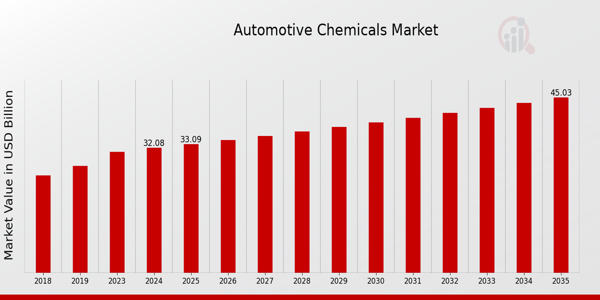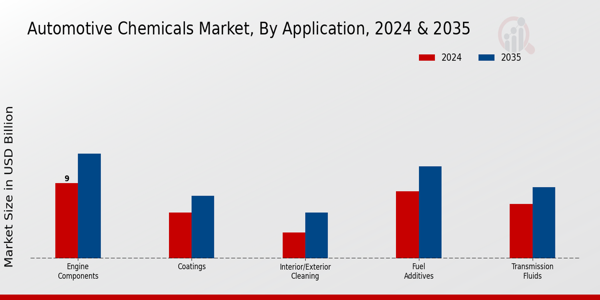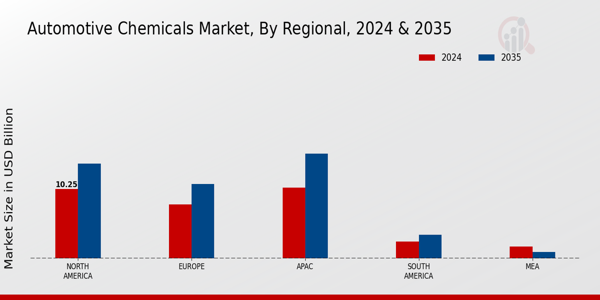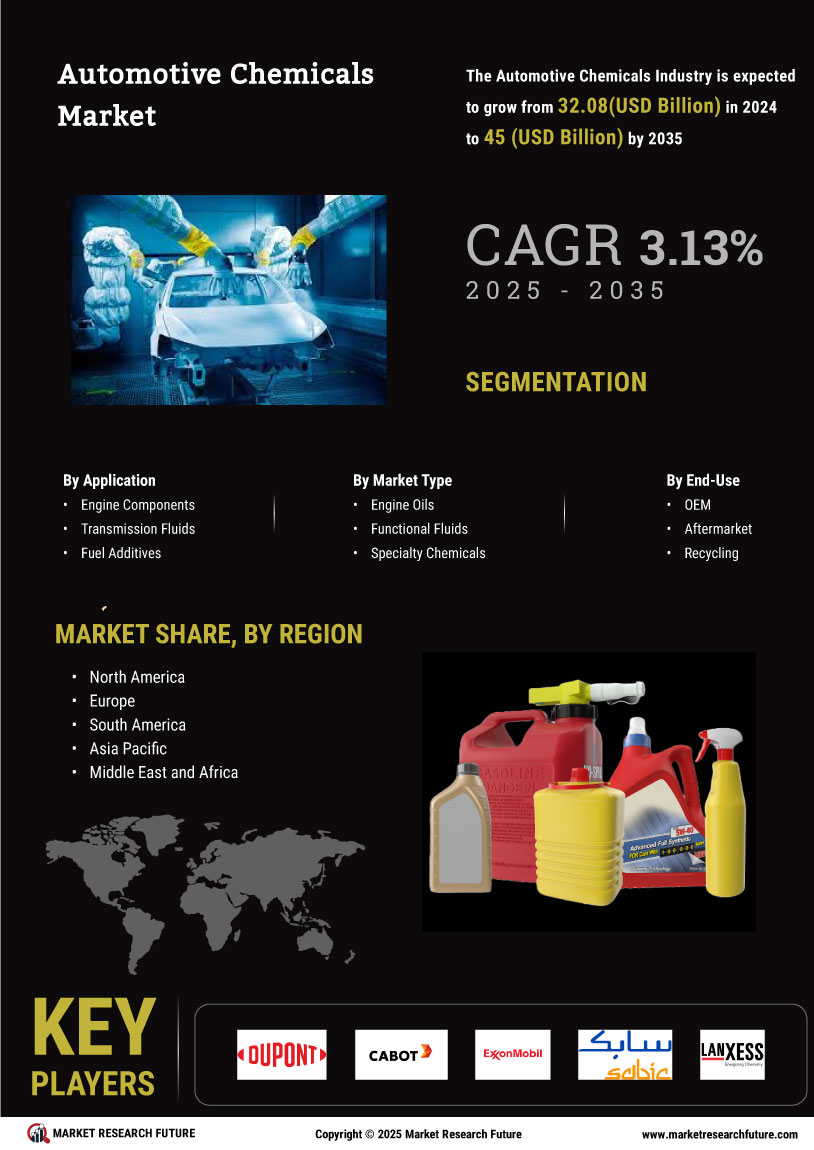Automotive Chemicals Market Summary
As per Market Research Future Analysis, the Global Automotive Chemicals Market was valued at 31.11 USD Billion in 2023 and is projected to grow to 45 USD Billion by 2035, with a CAGR of 3.13% from 2025 to 2035. The market is driven by increasing vehicle production, advancements in electric and hybrid vehicles, and stringent environmental regulations. Key applications include engine components, transmission fluids, and fuel additives, which are essential for enhancing vehicle performance and sustainability.
Key Market Trends & Highlights
The Automotive Chemicals Market is undergoing significant transformations driven by sustainability and technological advancements.
- Automotive Chemicals Market Size in 2024: 32.08 USD Billion; expected to reach 45 USD Billion by 2035.
- Engine Components projected to grow from 9.0 USD Billion in 2024 to 12.5 USD Billion by 2035.
- Electric vehicle sales anticipated to reach 30 million units by 2030, increasing demand for specialized chemicals.
- North America to dominate the market with a valuation of 10.25 USD Billion in 2024, growing to 14.0 USD Billion by 2035.
Market Size & Forecast
2023 Market Size: USD 31.11 Billion
2024 Market Size: USD 32.08 Billion
2035 Market Size: USD 45 Billion
CAGR (2025-2035): 3.13%
Largest Regional Market Share in 2024: North America.
Major Players
Key Companies include DuPont, Cabot, ExxonMobil, SABIC, Lanxess, Shell, Sumitomo Chemical, Ashland, AkzoNobel, Dow, LyondellBasell, BASF, Westlake Chemical, Honeywell, Clariant.
Key Automotive Chemicals Market Trends Highlighted
The increasing demand for sustainable practices and environmentally friendly goods is causing a shift in the Automotive Chemicals Market. The development and use of sophisticated automotive chemicals that meet these criteria are becoming a top priority for automakers as governments across the world implement more stringent laws intended to lower emissions and boost fuel economy.
The market is being shaped by this need for sustainability, as recycled and bio-based products are becoming more popular. Furthermore, a new wave of innovation in automotive chemicals has been sparked by the growth of electric cars (EVs), with an emphasis on high-performance materials that satisfy the particular needs of EV technology.
Expanding the manufacturing of specialized chemicals and investigating new markets in emerging nations where automobile production is increasing are two opportunities to be investigated in the global market. There is a growing need for effective and superior automotive chemicals as emerging countries embrace the production of automobiles.
In line with international sustainability goals, suppliers can use technology developments in chemical manufacturing to enhance performance and lessen environmental effect as the sector develops. The automobile industry has seen a noticeable shift in recent years toward digitization, which has an effect on the management and production of chemicals.
Businesses are spending money on digital technologies like the Internet of Things (IoT) and data analytics, which enable more effective supply chain management and product development procedures. The need for specialized automotive chemicals that support novel manufacturing processes and components keeps rising as car designs get more intricate.
All things considered, because of the dynamic nature of the Automotive Chemicals Market, players must continue to be flexible and sensitive to these changing trends while seizing the chances brought about by a more competitive environment.

Source: Primary Research, Secondary Research, Market Research Future Database and Analyst Review
Automotive Chemicals Market Drivers
Increasing Demand for Electric Vehicles
The shift towards Electric Vehicles (EVs) is one of the key drivers for the growth of the Automotive Chemicals Market. According to the International Energy Agency, the global stock of electric cars reached 10 million units in 2020, marking a 43% increase from 2019.
Governments worldwide are introducing incentives and regulations to promote EV adoption, which will, in turn, boost the demand for automotive chemicals used in battery production, coatings, and other components.
Organizations such as the United Nations are also supporting initiatives that encourage cleaner transport. This increasingly robust regulatory framework is expected to influence the market significantly over the next decade.
Rising Global Vehicle Production
The overall increase in vehicle production is a primary driver of the Automotive Chemicals Market. Global vehicle production surpassed 95 million units in 2021, and as the automotive industry rebounds post-COVID-19, the production numbers are projected to rise even higher.
The World Manufacturers Organization has reported a 4% annual growth in vehicle output leading to heightened demand for automotive chemicals such as lubricants, adhesives, and paints. This trend is further supported by initiatives from established automobile manufacturers investing in innovative materials, which will drive the market forward.
Technological Advancements in Automotive Chemicals
Technological innovations in automotive chemicals significantly enhance their performance and environmental sustainability, thereby fostering market growth. Research and Development (R&D) efforts lead to the creation of new formulations with superior characteristics, such as lightweight materials, which are crucial in improving fuel efficiency.
For example, research conducted by the Society of Automotive Engineers indicates a demand for lighter materials that can reduce vehicle weight by up to 20%. As companies like BASF and DuPont invest heavily in advanced automotive chemical technologies, this trend propels the Automotive Chemicals Market towards greater efficiency and sustainability.
Growing Focus on Sustainable and Eco-Friendly Products
The increasing awareness of environmental issues is driving a shift towards sustainable automotive chemicals. Global initiatives, including the European Union's Green Deal aiming for carbon neutrality by 2050, emphasize the need for eco-friendly solutions in various industries, including automotive.
Reports suggest that by 2025, the demand for biobased automotive chemicals could account for up to 30% of the market, influenced by consumer preferences and stricter regulations. Companies such as Arkema and Bayer are pioneering the development of greener materials, effectively responding to this market dynamism and spurring growth within the Automotive Chemicals Market.
Automotive Chemicals Market Segment Insights
Automotive Chemicals Market Application Insights
The Automotive Chemicals Market demonstrated a robust segmentation, particularly within the Application segment, comprising critical areas such as Engine Components, Transmission Fluids, Fuel Additives, Coatings, and Interior/Exterior Cleaning.
In 2024, the revenue for Engine Components was notably prominent, being valued at 10.5 USD Billion, illustrating its major role in the overall market dynamics. This is projected to increase to 14.0 USD Billion by 2035, highlighting its significance as engines integrate more advanced technologies and face stringent regulations for performance and emissions.
Transmission Fluids, valued at 5.8 USD Billion in 2024, are also anticipated to grow to 7.5 USD Billion over the same period. Their importance cannot be overstated, as they ensured optimal functioning of the drivetrain and are pivotal for vehicle efficiency.
Furthermore, Fuel Additives represented another essential segment with a projected valuation of 4.2 USD Billion in 2024, climbing to 5.5 USD Billion in 2035. These additives played a critical role in improving fuel quality, enhancing engine performance, and reducing emissions, contributing to an eco-friendly automotive environment.
Coatings held a valuation of 6.0 USD Billion in 2024, with estimates suggesting this will grow to 8.0 USD Billion by 2035. This area emphasized the importance of protective finishes in vehicles that safeguard against environmental damage, increasing both aesthetic appeal and vehicle longevity.
Lastly, Interior/Exterior Cleaning had a revenue of 5.58 USD Billion in 2024, which is expected to climb to 10.0 USD Billion in 2035, reflecting growing market trends toward maintenance and aesthetics in automotive care.
The comprehensive Automotive Chemicals Market data indicated that these applications are fundamental to enhancing vehicle performance, safety, and sustainability. Market growth is driven by advancements in automotive technologies, the shift towards greener alternatives, and a rising consumer demand for longevity and reliability in vehicle maintenance.
Each area within the Application segment demonstrated unique growth patterns, influenced by factors like regulatory changes and technological innovations, presenting both opportunities and challenges within this expansive market landscape. Hence, understanding these nuances was vital for stakeholders as they navigate the Automotive Chemicals Market and its future trajectories.

Source: Primary Research, Secondary Research, Market Research Future Database and Analyst Review
Automotive Chemicals Market Type Insights
The Automotive Chemicals Market is segmented into various Types, mainly including Engine Oils, Functional Fluids, Specialty Chemicals, Additives, and Cleaners. Engine oils are essential for reducing friction and wear, significantly contributing to the performance and longevity of vehicles.
Functional fluids, such as transmission fluids and cooling fluids, play a critical role in system efficiency and operational stability, often representing a significant portion of the market due to their diverse applications.
Specialty chemicals find their relevance in optimizing performance and standardizing production processes, forming an important segment driven by innovations and technological advancements.
Additives enhance product characteristics, ensuring compliance with stringent environmental regulations, while cleaners are indispensable for vehicle maintenance and upkeep. The interplay of these segments fuels market growth, supported by increasing vehicle production and the rising emphasis on vehicle performance and longevity amidst evolving industry standards and consumer preferences.
Global statistics reflect a steady demand curve driven by these factors, making the automotive chemicals landscape exceedingly dynamic.
Automotive Chemicals Market End-use Insights
The Automotive Chemicals Market is significantly influenced by its End-use segmentation, which encompasses Original Equipment Manufacturer (OEM), Aftermarket, and Recycling applications. The OEM segment is crucial as it represents the initial use of automotive chemicals during vehicle production, ensuring quality and compliance with regulatory standards.
The Aftermarket segment plays a vital role as it caters to maintenance and repair needs, driven by the increasing number of vehicles on the road and the growing focus on sustainability. Meanwhile, the Recycling aspect is gaining momentum due to enhanced regulations and the push for environmentally friendly practices, reflecting a global trend towards resource efficiency.
As the market continues to evolve, factors such as technological innovations, regulatory pressures, and shifting consumer preferences are likely to drive the Automotive Chemicals Market growth. Overall, this market segmentation provides a comprehensive outlook on the significant roles these categories play in shaping the industry's future landscape.
Automotive Chemicals Market Regional Insights
The Automotive Chemicals Market is on a growth trajectory across various regions, with significant valuations expected by 2024. North America led the market with a valuation of 10.5 USD Billion, projected to rise to 14.83 USD Billion by 2035.
Europe closely followed, valued at 9.8 USD Billion in 2024, and anticipated to reach 13.52 USD Billion by 2035, driven by stringent regulations promoting advanced automotive technologies. In Asia Pacific, the valuation stood at 7.58 USD Billion in 2024, with expectations to grow to 10.84 USD Billion by 2035, highlighting its importance as a manufacturing hub for the automotive industry.
South America and the Middle East and Africa had lower valuations of 2.5 USD Billion and 1.7 USD Billion respectively in 2024, but they represented growing markets with significant potential due to increasing investments in automotive infrastructure.
The Automotive Chemicals Market segmentation reflected diverse growth opportunities across these regions, influenced by consumer preferences, regulatory standards, and economic conditions. The market continues to expand as automotive manufacturers focus on sustainable practices and innovative chemical solutions, providing an array of opportunities within the industry.

Source: Primary Research, Secondary Research, Market Research Future Database and Analyst Review
Automotive Chemicals Market Key Players and Competitive Insights
The Automotive Chemicals Market is characterized by intense competition and continuous innovation as manufacturers strive to develop advanced materials that meet stringent regulatory standards and consumer demands.
This market encompasses a wide array of chemical products utilized in the automotive manufacturing process, including coatings, adhesives, sealants, rubber, and performance additives. Competitive dynamics are defined by the growing need for environmentally friendly solutions and the push for enhanced performance characteristics in automotive applications.
Emerging technologies, fluctuation in raw material prices, and the increasing emphasis on sustainability are key factors influencing the competitive landscape.
Companies within this sector are actively engaged in strategic collaborations, mergers, and acquisitions to bolster their product offerings and expand their geographic reach, thus contributing to a rapidly evolving market scenario that prioritizes innovation and efficiency.
Lubrizol stands out in the Automotive Chemicals Market through its focus on high-performance additives that enhance the efficiency and lifespan of automotive components. The company’s strength lies in its commitment to research and development, which allows it to formulate products that cater to the evolving needs of automotive manufacturers.
By leveraging its technological expertise, Lubrizol has established a robust market presence, particularly in the area of engine oils, where its additives significantly improve fuel economy and reduce emissions. The company's global footprint underscores its capacity to serve diverse markets, and it has built strong partnerships with leading automotive OEMs.
This strategic positioning enables Lubrizol to maintain a competitive edge, as it can swiftly adapt to changing market trends while promoting sustainable and innovative solutions tailored for the automotive sector.
Chevron Phillips Chemical plays a significant role in the Automotive Chemicals Market, offering a broad range of products that meet the diverse requirements of the automotive industry. The company's key offerings include polyalphaolefins and a variety of specialty chemicals that are crucial for lubricants and plastic components.
Chevron Phillips Chemical is recognized for its operational efficiency and strong emphasis on technological advancement, allowing it to maintain a competitive stance in various global markets. The company's strategic mergers and acquisitions have bolstered its product portfolio and expanded its presence across different regions.
With a commitment to sustainability, Chevron Phillips Chemical integrates eco-friendly practices into its production processes, thus catering to the increasing demand for greener automotive solutions. Overall, its comprehensive range of products, proactive approach to innovation, and strategic market positioning contribute to its strength within the competitive landscape of the global automotive chemicals sector.
As a leading automotive chemicals supplier, we deliver high-performance oils, coolants, cleaners, and sealants designed for garages, fleets, and vehicle manufacturers.
Key Companies in the Automotive Chemicals Market Include
- Lubrizol
- Chevron Phillips Chemical
- Momentive Performance Materials
- Shell
- Fuchs Petrolub
- Afton Chemical
- BASF
- Huntsman
- Evonik Industries
- Reliance Industries
- Arkema
- Solvay
- Dow
- 3M
- SABIC
Automotive Chemicals Market Developments
At Automechanika in September 2024, BASF Coatings unveiled its ChemCycling® clearcoat solutions, which use recycled tire feedstock to produce high-end clearcoats that reduce CO2 emissions and increase energy efficiency.
The company's groundbreaking EFFLORESCENCE monocoat, which permits low-temperature drying and lowers line complexity in vehicle painting, also earned it a coveted Red Dot Design award in October 2024. NIO and BASF Coatings launched a strategic agreement in March 2025 to provide OEM-grade exterior coatings for NIO's electric vehicles, promoting sustainable cooperation and long-term color design.
In the meanwhile, PPG Industries demonstrated its most recent developments in automobile OEM coating systems in June 2025, emphasizing increased productivity and business resilience. These innovations included sustainable powder coatings, overspray-free precise application, and its digital PPG LINQTM environment.
Further demonstrating the increasing use of innovative chemicals in next-generation car components, BASF also announced new mobility solutions at the Battery Show Europe in May 2025, such as robust polyurethane composite coverings for EV battery packs.
These advancements highlight the trend toward environmentally friendly, energy-efficient, and technologically advanced chemical solutions for OEM, electric car, and automotive refinish applications.
Automotive Chemicals Market Segmentation Insights
-
Automotive Chemicals Market Application Outlook
- Engine Components
- Transmission Fluids
- Fuel Additives
- Coatings
- Interior/Exterior Cleaning
-
Automotive Chemicals Market Type Outlook
- Engine Oils
- Functional Fluids
- Specialty Chemicals
- Additives
- Cleaners
-
Automotive Chemicals Market End-use Outlook
- OEM
- Aftermarket
- Recycling
-
Automotive Chemicals Market Regional Outlook
- North America
- Europe
- South America
- Asia Pacific
- Middle East and Africa
| Report Attribute/Metric |
Details |
| Market Size 2023 |
31.11(USD Billion) |
| Market Size 2024 |
32.08(USD Billion) |
| Market Size 2035 |
45.0(USD Billion) |
| Compound Annual Growth Rate (CAGR) |
3.12% (2025 - 2035) |
| Report Coverage |
Revenue Forecast, Competitive Landscape, Growth Factors, and Trends |
| Base Year |
2024 |
| Market Forecast Period |
2025 - 2035 |
| Historical Data |
2019 - 2024 |
| Market Forecast Units |
USD Billion |
| Key Companies Profiled |
Lubrizol, Chevron Phillips Chemical, Momentive Performance Materials, Shell, Fuchs Petrolub, Afton Chemical, BASF, Huntsman, Evonik Industries, Reliance Industries, Arkema, Solvay, Dow, 3M, SABIC |
| Segments Covered |
Application, Type, End-use, Regional |
| Key Market Opportunities |
increased electric vehicle production, growth in sustainable materials, demand for lightweight components, advancements in automotive coatings, expansion in emerging markets |
| Key Market Dynamics |
sustainable product demand, regulatory compliance pressures, technological advancements, supply chain disruptions, rising raw material costs |
| Countries Covered |
North America, Europe, APAC, South America, MEA |
Frequently Asked Questions (FAQ):
The Automotive Chemicals Market was valued at 32.08 USD Billion in 2024.
By 2035, the Automotive Chemicals Market is projected to reach a value of 45.0 USD Billion.
The expected CAGR for the Automotive Chemicals Market from 2025 to 2035 is 3.12%.
North America held the largest share in the Automotive Chemicals Market, valued at 10.5 USD Billion in 2024.
The market value of Asia Pacific in the Automotive Chemicals Market was 7.58 USD Billion in 2024.
The Engine Components application segment was valued at 10.5 USD Billion in 2024.
BASF is recognized as one of the key competitors in the Automotive Chemicals Market.
The Interior/Exterior Cleaning segment is projected to be valued at 10.0 USD Billion in 2035.
The market value for Transmission Fluids is anticipated to be 7.5 USD Billion in 2035.
The expected market value of the South America region in the Automotive Chemicals Market is 3.38 USD Billion by 2035.

















